Article citation information:
Budzyński,
A., Cieśla, M. Application of a machine learning
model for forecasting freight rate in road transport. Scientific Journal of Silesian University of Technology. Series
Transport. 2025, 126, 23-48.
ISSN: 0209-3324. DOI: https://doi.org/10.20858/sjsutst.2025.126.2.
Artur BUDZYŃSKI[1],
Maria CIEŚLA[2]
APPLICATION OF A MACHINE LEARNING MODEL FOR FORECASTING FREIGHT RATE IN
ROAD TRANSPORT
Summary. Recent global
trends related to the forecasting freight prices is a complex task that
involves considering various factors and variables that can affect the pricing
dynamics in the sustainable transportation industry and business. Since freight
price forecasting is subject to various uncertainties, including unforeseen
events and market fluctuations, scientists are working on methods and tools,
which also include artificial intelligence methods, to improve this process.
The research purpose of this study is to present a universal machine learning
based method enabling forecast freight prices for decision-making in the field
of road transport. The paper presents the methodological assumptions of the
model and shows an example of its use. The analysis was carried out with Python
programming language and experiments were performed in Jupyter
Notebook. Pandas library was used in research. The
influence of individual variables was demonstrated using the eli5 library. The analysis allowed to conclude that machine
learning models can be effective in forecasting freight prices in the context
of sustainable transport due to their ability to capture complex patterns and
relationships in large datasets.
Keywords: forecasting
model, freight price, freight rate, machine learning, road transport,
sustainable transport
1.
INTRODUCTION
The freight price or freight rate refers to the charges
or fees associated with the transportation of goods or cargo from one point to
another. It is associated with the transportation cost that a shipper or
consignee is charged for the transportation of goods. For this reason, in many
companies, it is one of the most important elements of decision rationalization
in the field of transport processes. This is a very difficult process because
it involves making decisions about changing external conditions. In addition,
the dynamics of the global economy are shaped, among others, by transportation
costs
There is no strictly defined formula for determining the
freight rate, because its amount varies depending on the specific
circumstances, such as mode of transportation (road, rail, maritime, air),
distance, pickup and delivery points of the shipment, speed of transport
(ordinary or express service), type of shipment, weight, size, and other.
In the case of the freight rate concerning road
transport, the prices of fuel and tolls are the most important. In addition,
the margin is included here, which is the ratio of gross profit from sales to
revenues and results from the market situation and the mutual relationship
between supply and demand. As a result, transportation costs can potentially
have a significant impact on the final price of the goods transported
Because of such necessity, the scientific purpose of this
study is to present a universal model supporting sustainable decision-making to
forecast the price for road freight transport using machine learning (ML)
techniques. The study is organized as follows: Section 2 includes a brief
scientific literature review of freight rate forecasting techniques and
achievements. Section 3 describes the machine learning model for forecasting
freight rates methodology. Section 4 presents the model test results, which are
further followed by a discussion in Section 5. The paper ends with the
conclusions resulting from the theoretical and research parts in Section 6.
2. SCIENTIFIC LITERATURE REVIEW
The analysis of the literature in the researched area was
based on the resources of the Web of Science and Scopus databases. Searching
the databases with the keywords "freight rate(s)" allowed us to
extract only 576 documents from 2000 to 2023, mainly articles (334), conference
papers (162), book chapters (25), reviews (23) and other types. The authors of
the publications are mainly scientists from: China (20), the United States
(94), the United Kingdom (45), Germany (30), Greece (29) and other countries.
The co-occurrence analysis of all, 4983 keywords in the database allowed us to
construct and visualize bibliometric networks of 100 common keywords related to
the topic of freight rates with the VOSviewer software tool presented in Fig. 1.
Fig. 1. Bibliometric network visualization of all keywords related to freight
rates
The bibliometric network visualization of the
keywords allowed us to identify six clusters related to freight rates. Cluster
1 refers to 20 items, railroad transportation, freight trains, and railroads.
Cluster 2 with 18 items relates to shipping, transportation economics,
import-export, and price dynamics. Cluster 3 applies to 17 items of freight
rate with forecasting, commerce, market, and competition. It is closely related
to waterway transportation, container ships, tankers, shipbuilding, and
container shipping. Next cluster 4 refers to 16 elements connected with
decision-making, optimization, simulation, algorithms and mathematical models.
Cluster 5 refers to 12 items associated with freight transportation,
cost-benefit analysis, emission controls, and carbon dioxide, etc. The last
cluster 6 relates to 8 items related to costs, economic analysis, fuels,
exchange rate marketing, investments, etc. This analysis shows that there is a
lack of research in the area of forecasting freight rates in road transport.
For further analysis, more documents were analyzed, not only the ones which
have the words in the keywords.
When
analyzing the literature related to freight rate forecasting, a major
contribution is found in waterborne transportation. Nielsen et al.
A
critical characteristic influencing freight rates is their unpredictability and
volatility, and therefore the work of scientists such as Kasimati
and Veraros
Automated
forecasting combines data statistics and machine
learning techniques to predict future features or values. Building accurate
forecasting models based on computer algorithms and data-driven methods saves
time and effort compared to manual forecasting methods, especially when dealing
with large datasets and complex patterns. For example, Auto-ARIMA
(acronym: Auto-Regressive Integrated Moving Average), used by Choudhary et al.
There
are many machine learning techniques applied to automated forecasting in
previous works. Multiple kernel learning (MKL)
techniques are shown in the research of Widodo et al.
Considering
the research gap in the literature, especially visible in the field of road
transportation, the study contributes to freight rate forecasting. In this
manuscript, we propose a machine learning model to forecast road freight rates
to support sustainable decisions of shippers and carriers. Compared to previous
methodologies, the main advantage of this forecasting model is its uniqueness
and usefulness. It is possible to adapt the model to other decision-making
conditions based on the machine learning model lifecycle procedure, from the
initial stage related to data gathering to the final stage of model deployment.
In addition, the manuscript also presents the use of a model for use in the
conditions of European Union freight transportation.
3. MACHINE LEARNING MODEL FOR FORECASTING
FREIGHT RATES
Building a machine learning model for forecasting
freight rates is more like a process of continuous improvement than work that
can eventually be completed. The work involved in creating a model can be
visualized using a cyclical process. This process, presented graphically in
Fig. 2, is commonly referred to as the lifecycle of the machine learning model.
It consists of seven elements: gathering data, data preparation, data
wrangling, analyzing data, model training, test model and deployment. The chart
presents a basic methodology for building a machine learning model for
forecasting freight rates in the research part of this article. The basic
assumption, the methodology related to the construction of the model described
in this work, is to be transparent and universal enough to be able to use the
model in free-market conditions. In the presented research work, we use
statistical methods. We use the regression analysis method to build a model
predicting the price for the road freight transport service.
We use the Python programming
language to complete the project. The experiments are carried out in Jupyter Notebook
Furthermore, data on 2748
transport offers from the free market were collected. The free market means
transport exchanges where potential customers report their need for a transport
service.
The data are recorded according
to 52 variables. Including the input variable presented in Tab.
1
and the output variable denoting the price in € currency. We propose to divide
the input variables into 4 categories: distance, relation, cargo and
organization. Each category will be discussed in detail in the following
sections. Not all variables are fully completed. The data missing did not
concern the necessary characteristics. This is related to the work methodology,
which will be discussed for each feature.

Fig.
2. Machine Learning Model
Lifecycle
The
dataset presents 3 types of variables: "object", "float64" and "int64".
The variable type "int" is integer and
"float" is floating point. The "object" variable is a value
that represents a non-numeric value
The
distance category determines the number of kilometers in each country. The
number of countries is limited to those through which the transports from the
research sample arrived.
The
relationship describes the initial loading location and the last unloading
location. This is done using a postcode consisting of 2 letters and 5 numbers.
For countries with a 4-digit code, the last one is completed as 0 to
standardize the notation.
Date
describes the date and time of the first loading and last unloading. The
feature is represented as a range from to. The cargo category contains all the
features related to the specifications of the goods. The organizational
category describes other features.
Tab. 1
Key
data about the dataset
|
Feature Category |
Feature Name |
Dtype |
Completeness of Data |
|
Distance |
AT_KM |
float64 |
100.00% |
|
Distance |
BE_KM |
float64 |
100.00% |
|
Distance |
CZ_KM |
float64 |
100.00% |
|
Distance |
DE_KM |
float64 |
100.00% |
|
Distance |
DK_KM |
float64 |
100.00% |
|
Distance |
EE_KM |
float64 |
100.00% |
|
Distance |
ES_KM |
float64 |
100.00% |
|
Distance |
FI_KM |
float64 |
100.00% |
|
Distance |
HR_KM |
float64 |
100.00% |
|
Distance |
FR_KM |
float64 |
100.00% |
|
Distance |
HU_KM |
float64 |
100.00% |
|
Distance |
IT_KM |
float64 |
100.00% |
|
Distance |
LT_KM |
float64 |
100.00% |
|
Distance |
LV_KM |
float64 |
100.00% |
|
Distance |
NL_KM |
float64 |
100.00% |
|
Distance |
PL_KM |
float64 |
100.00% |
|
Distance |
RO_KM |
float64 |
100.00% |
|
Distance |
SE_KM |
float64 |
100.00% |
|
Distance |
SI_KM |
float64 |
100.00% |
|
Distance |
SK_KM |
float64 |
100.00% |
|
Relation |
COD_LP |
object |
100.00% |
|
Relation |
COD_DP |
object |
100.00% |
|
Date |
START_LOAD_DATA |
object |
100.00% |
|
Date |
START_LOAD_TIME |
object |
4.26% |
|
Date |
END_LOAD_DATA |
object |
100.00% |
|
Date |
END_LOAD_TIME |
object |
4.04% |
|
Date |
START_DELIVERY_DATA |
object |
100.00% |
|
Date |
START_DELIVERY_TIME |
object |
3.13% |
|
Date |
END_DELIVERY_DATA |
object |
100.00% |
|
Date |
END_DELIVERY_TIME |
object |
3.31% |
|
Date |
TIME_OF_ENTRY |
object |
89.63% |
|
Cargo |
GOODS_TYPE |
object |
93.81% |
|
Cargo |
BODY_TYPE |
object |
99.85% |
|
Cargo |
VEHICLE_TYPE |
object |
100.00% |
|
Cargo |
LOAD_UNLOAD_METHOD |
object |
99.96% |
|
Cargo |
REQUIREMENTS |
object |
0.07% |
|
Cargo |
EPALE |
int64 |
100.00% |
|
Cargo |
LDM |
float64 |
100.00% |
|
Cargo |
TONS |
float64 |
100.00% |
|
Cargo |
M3 |
float64 |
100.00% |
|
Cargo |
HEIGHT |
float64 |
0.11% |
|
Cargo |
WIDTH |
float64 |
100.00% |
|
Cargo |
CARGO_VALUE_EURO |
float64 |
0.07% |
|
Cargo |
TEMP_MIN |
float64 |
0.73% |
|
Cargo |
TEMP_MAX |
float64 |
0.73% |
|
Organizational |
OTHER_COSTS |
float64 |
100.00% |
|
Organizational |
QTY_LOADS |
float64 |
100.00% |
|
Organizational |
QTY_DELIVERIES |
float64 |
100.00% |
|
Organizational |
PAYMENT TERM |
float64 |
95.34% |
|
Organizational |
DOCUMENTS_BY |
object |
90.47% |
|
Organizational |
CUSTOMS |
int64 |
100.00% |
Tab. 2 presents basic statistical data for raw numerical
features. Based on the distance features, we created a new one called
"KM". It is simply the sum of kilometers across all countries. Before
analyzing the "KM" feature, it is worth paying attention to the fact
that a driver can work 13 hours between daily rests and extend this time to 15
hours 3 times a week. The driving time is 9 hours and can be extended to 10
hours twice a week
The "EPALE" feature is the number of pallets
that the vehicle needs to exchange at the loading site. It is an abbreviation
of "E Pallet Exchange". Statistical analysis clearly shows that most
transports do not require such an exchange.
The "LDM" feature comes from the abbreviation
"loading meters". The loading meters on the trailer are 2.4 meters
wide. The length of the cargo space in a set consisting of a tractor unit and a
semi-trailer is 13.6. After statistical analysis, it is concluded that the data
relates entirely to full truckload transport. The situation is similar in the case
of width, volume and weight.
Other costs concern a small group of shipments.
Transports most often have 1 loading and 1 unloading
point and rarely require customs clearance.
Tab. 2
Statistical analysis of raw numerical input data
|
Feature |
|
V |
q2 |
Min. |
Max. |
q1 |
q3 |
q |
Vq |
|
|
KM |
438.21 |
412.81 |
94.20 |
382.4 |
1 |
2439.5 |
53.6 |
710.0 |
328.2 |
85.83 |
|
EPALE |
0.06 |
1.37 |
2194.02 |
0 |
0 |
34 |
0 |
0 |
0 |
- |
|
LDM |
13.6 |
0.01 |
0.06 |
13.6 |
13.2 |
13.6 |
13.6 |
13.6 |
0 |
0 |
|
TONS |
24.57 |
2.15 |
8.73 |
25 |
1.52 |
25.7 |
25 |
25 |
0 |
0 |
|
M3 |
84.70 |
0.72 |
0.84 |
84.68 |
84.68 |
120 |
84.68 |
84.68 |
0 |
0 |
|
WIDTH |
2.4 |
0 |
0 |
2.4 |
2.4 |
2.4 |
2.4 |
2.4 |
0 |
0 |
|
OTHER_COSTS |
-3.95 |
45.96 |
-1164.81 |
0 |
-898.71 |
0 |
0 |
0 |
0 |
- |
|
QTY_LOADS |
1.01 |
0.10 |
10.35 |
1 |
1 |
4 |
1 |
1 |
0 |
0 |
|
QTY_DELIVERIES |
1.02 |
0.19 |
18.59 |
1 |
1 |
6 |
1 |
1 |
0 |
0 |
|
CUSTOMS |
0 |
0.04 |
2619.64 |
0 |
0 |
1 |
0 |
0 |
0 |
- |
The
next step is to examine the correlations between the features.
Fig.
3 presents a correlation matrix between features. We used Pearson's
correlation for this. It should be remembered that, in principle, not
everything that correlates with each other is dependent. The data concerns all
data without division by qualitative variables. We would like to draw attention
to the very high correlation between distance and price, equal to 0.92. This
relationship is obviously expected. Before the analysis, the question was not
whether there was a correlation, but how strong it was. The second important
relationship resulting from the correlation matrix is the inverse
proportionality of the price per kilometer to the distance. This confirms the
above-mentioned issue that short transports are more expensive per kilometer
than longer ones. There was no correlation between the price per kilometer and
the number of loading and unloading operations, customs clearance and the
number of pallets to be replaced. The fact that these dependencies do not
result from this matrix does not mean that such dependencies do not exist.
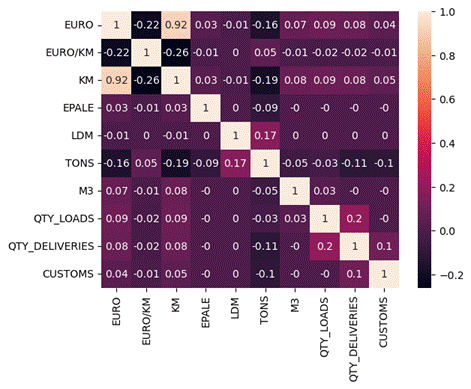
Fig. 3. Correlation Matrix
We
did a more thorough analysis of the distance variable. We made a histogram of
the distribution of the distance variable "KM" shown in
Fig.
4.
Bins are placed every 100 kilometers. Signatures on the X axis every 500
kilometers. The average is marked with a red line. The median is marked with a
green line. The statement made based on the statistical data from the table is
confirmed. Short transports predominate. Additionally, an irregular
distribution of the variable is observed.
The
sum of kilometers from the entire research sample is over 1.2 million
kilometers.
Fig.
5. Bar chart of kilometers by country
shows the distribution of this by country of occurrence. More than half of the
kilometers from the research sample are in Poland. Germany accounts for more
than a quarter. This means that less than a quarter goes to other countries.
Tab.
3 shows
the processing of all distance features. All raw data remain unchanged in the
model. One new feature is the sum of all the others, denoted KM.
For
the purposes of this work, relations are understood as the unique combination
of loading and unloading countries. Fig.
6
shows a heatmap of average prices per kilometer in
the relationship. The values shown in the chart are prices with additional
costs subtracted. We calculated them using the following formula:
![]() (1)
(1)
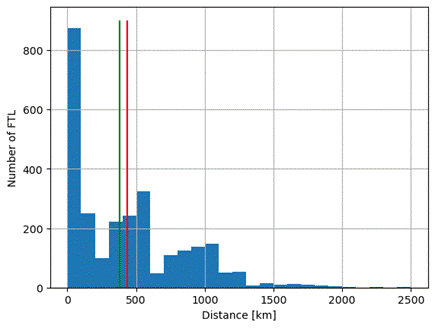
Fig. 4. Histogram of the distribution of the distance variable
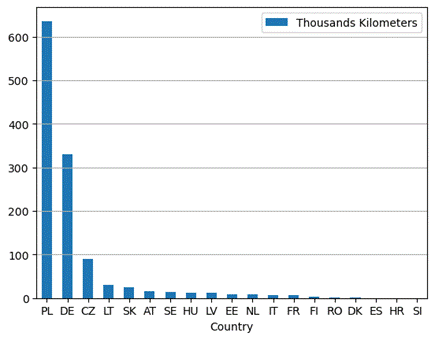
Fig. 5. Bar chart of kilometers by country
The
analyzed research sample does not present transports in every relation. Full
data only apply to transports from and to Poland. The highest price is
presented in the domestic report in Poland. This is related to the large group
of short transports on this route.
Tab. 3
Processing distance feature data
|
Raw Feature |
Processed Feature |
|
AT_KM |
AT_KM |
|
BE_KM |
BE_KM |
|
CZ_KM |
CZ_KM |
|
DE_KM |
DE_KM |
|
DK_KM |
DK_KM |
|
EE_KM |
EE_KM |
|
ES_KM |
ES_KM |
|
FI_KM |
FI_KM |
|
HR_KM |
HR_KM |
|
FR_KM |
FR_KM |
|
HU_KM |
HU_KM |
|
IT_KM |
IT_KM |
|
LT_KM |
LT_KM |
|
LV_KM |
LV_KM |
|
NL_KM |
NL_KM |
|
PL_KM |
PL_KM |
|
RO_KM |
RO_KM |
|
SE_KM |
SE_KM |
|
SI_KM |
SI_KM |
|
SK_KM |
SK_KM |
|
|
KM |
The
analyzed research sample does not present transports in every relation. Full
data only apply to transports from and to Poland. The highest price is
presented in the domestic report in Poland. This is related to the large group
of short transports on this route.
Tab.
4
shows the process of processing relation features. The raw data only contains
the codes of the initial loading location and the last unloading location. On
their basis, the country of loading and unloading are determined. On their
basis, another feature called "RELATION" is created. This is a unique
combination of loading and unloading country. For each unique value, We calculated: mean, median and standard deviation. Based on
this, we created new features. The same way for "COUNTRY_LOAD_PLACE",
"COUNTRY_DELIVERY_ PLACE" and
"RELATION".
Fig.
7
shows the variable year distribution histogram. The number of transports from
2018 and 2019 is very small. The largest number of transports in the set are
from 2020-2022.
Tab.
5
shows the process of creating date features. There are 4 features for the date
and 5 features for the time. The time data is entered unchanged. The date data
needs to be processed. We processed the date obtaining the following information:
year, month, week of the year, day of the year, day of the week and day of the
month.
We
analyzed the seasonality in international transport. The results are shown in
the Fig.
8.
The minimum price is in January and the maximum in May.
An
upward trend is visible between January and May. The exception to this trend is
April. The price in April is lower than in March. However, the upward trend
between March and May is maintained.
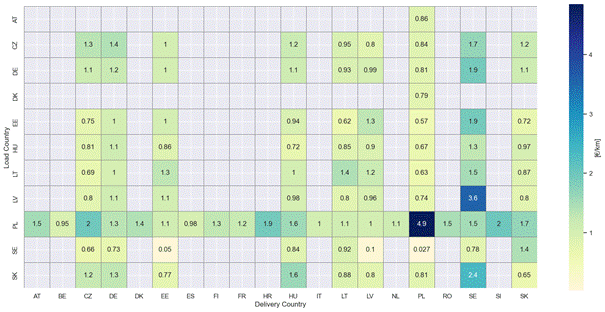
Fig. 6. Heatmap of average rates per kilometer in the
relation
Tab.
4
Processing
of relation data
|
Raw Feature |
Processed Feature |
|
COD_LP |
COUNTRY_LOAD_PLACE_FACTORIZED |
|
COUNTRY_LOAD_PLACE_MEAN |
|
|
COUNTRY_LOAD_PLACE_MEDIAN |
|
|
COUNTRY_LOAD_PLACE_STD |
|
|
COD_DP |
COUNTRY_DELIVERY_PLACE_FACTORIZED |
|
COUNTRY_DELIVERY _PLACE_MEAN |
|
|
COUNTRY_DELIVERY _PLACE_MEDIAN |
|
|
COUNTRY_DELIVERY _PLACE_STD |
|
|
RELATION_PLACE_FACTORIZED |
|
|
RELATION_DELIVERY _PLACE_MEAN |
|
|
RELATION_DELIVERY _PLACE_MEDIAN |
|
|
RELATION_DELIVERY _PLACE_STD |
Similarly,
a downward trend is visible between May and January. The exception to this
trend is September, when the price is lower than in October. However, the
downward trend between August and October is maintained.
Tab.
6
shows the cargo data processing. The creation of features here should be
divided into 2 methods. The first involves calculating: mean, median, standard
deviation and assigning a category to each variable through factorization. This
applies to the following features: goods type, body type, vehicle type, load
and unload method, requirements.
The
second one is to use the numerical feature as it is, this applies to the
following features: euro pallets exchange, loading meters, tons, m3, height, width.
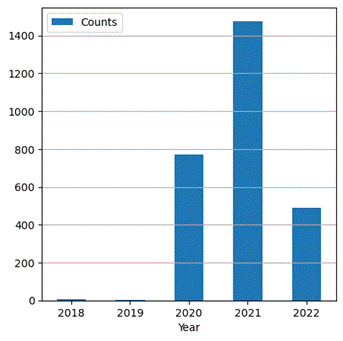
Fig. 7. Histogram of the year variable
Tab. 5
Date data processing
|
Raw Feature |
Processed Feature |
|
START_LOAD_DATA |
START_LOAD_DATA_DAY |
|
START_LOAD_DATA_WEEKDAY |
|
|
START_LOAD_DATA_DAY_OF_YEAR |
|
|
START_LOAD_DATA_WEEK |
|
|
START_LOAD_DATA_MONTH |
|
|
START_LOAD_DATA_YEAR |
|
|
START_LOAD_TIME |
START_LOAD_TIME |
|
END_LOAD_DATA |
END_LOAD_DATA _DAY |
|
END_LOAD_DATA _WEEKDAY |
|
|
END_LOAD_DATA
_DAY_OF_YEAR |
|
|
END_LOAD_DATA _WEEK |
|
|
END_LOAD_DATA _MONTH |
|
|
END_LOAD_DATA _YEAR |
|
|
END_LOAD_TIME |
END_LOAD_TIME |
|
START_DELIVERY_DATA |
START_DELIVERY_DATA _DAY |
|
START_DELIVERY _DATA _WEEKDAY |
|
|
START_DELIVERY
_DATA _DAY_OF_YEAR |
|
|
START_DELIVERY _DATA _WEEK |
|
|
START_DELIVERY _DATA _MONTH |
|
|
START_DELIVERY _DATA _YEAR |
|
|
START_DELIVERY_TIME |
START_DELIVERY_TIME |
|
END_DELIVERY_DATA |
END_DELIVERY_DATA _DAY |
|
END_DELIVERY_DATA _WEEKDAY |
|
|
END_DELIVERY_DATA
_DAY_OF_YEAR |
|
|
END_DELIVERY_DATA _WEEK |
|
|
END_DELIVERY_DATA _MONTH |
|
|
END_DELIVERY_DATA _YEAR |
|
|
END_DELIVERY_TIME |
END_DELIVERY_TIME |
|
TIME_OF_ENTRY |
TIME_OF_ENTRY |

Fig. 8. Price depends on the month
Tab. 6
Cargo data processing
|
Raw Feature |
Processed Feature |
|
GOODS_TYPE |
GOODS_TYPE_FACTORIZED |
|
GOODS_TYPE_MEAN |
|
|
GOODS_TYPE_MEDIAN |
|
|
GOODS_TYPE_STD |
|
|
BODY_TYPE |
BODY_TYPE _FACTORIZED |
|
BODY_TYPE _MEAN |
|
|
BODY_TYPE _MEDIAN |
|
|
BODY_TYPE _STD |
|
|
VEHICLE_TYPE |
VEHICLE_TYPE _FACTORIZED |
|
VEHICLE_TYPE _MEAN |
|
|
VEHICLE_TYPE _MEDIAN |
|
|
VEHICLE_TYPE _STD |
|
|
LOAD_UNLOAD_METHOD |
LOAD_UNLOAD_METHOD _FACTORIZED |
|
LOAD_UNLOAD_METHOD _MEAN |
|
|
LOAD_UNLOAD_METHOD _MEDIAN |
|
|
LOAD_UNLOAD_METHOD _STD |
|
|
REQUIREMENTS |
REQUIREMENTS_FACTORIZED |
|
REQUIREMENTS_MEAN |
|
|
REQUIREMENTS_MEDIAN |
|
|
REQUIREMENTS_STD |
|
|
EPALE |
EPALE |
|
LDM |
LDM |
|
TONS |
TONS |
|
M3 |
M3 |
|
HEIGHT |
HEIGHT |
|
WIDTH |
WIDTH |
Fig.
9
shows body type variable distribution. The data is not diverse. The dominant
body type is the standard type. All types whose number was less than 10 were
marked as other.
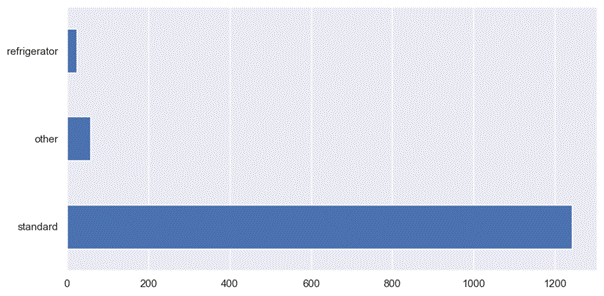
Fig. 9. Distribution of the body type variable
Tab.
7
shows the median rate per km of route by body type. The most expensive is the
refrigerator. This is related to increased vehicle operating costs. This type
of vehicle has refrigeration equipment that consumes fuel and generates costs.
The analysis of the distribution of the
commodity type variable is presented in Fig.
10.
The item type that occurred once was replaced with the "other" value.
The dominant share of steel in the test sample is clearly visible.
Fig.
11
shows the distribution of the loading/unloading type variable. The most common
method is a combination of all possible methods.
Tab.
8
shows the median price per kilometer according to the loading/unloading method
required by the client.
We
introduced the features prepared according to the description in the previous
chapter into the models. We selected 5 different machine learning models for
comparison. They were compared with each other according to the MAPE (Mean Absolute Percentage Error) metric. The results
are shown in Fig.
12.
In
the next step, we check what features were most important for the best XGBRegressor model. We use the eli5
library for this purpose. Fig.
13
shows the most important features for the model along with its weight. We will
look at the importance of features from the perspective of the categorization
described in section 3. The most important is distance (0.28 KM, 0.05 SE_KM).
Tab. 7
Median
rate per km of route by body type
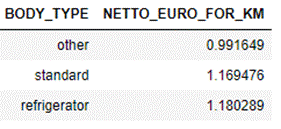
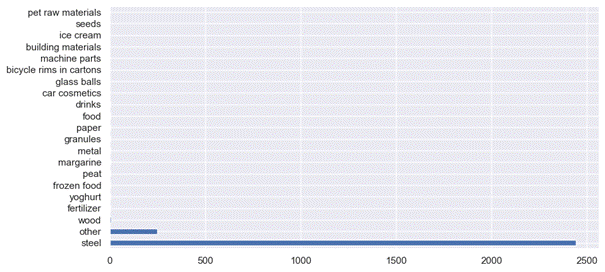
Fig. 10. Distribution of the goods type variable
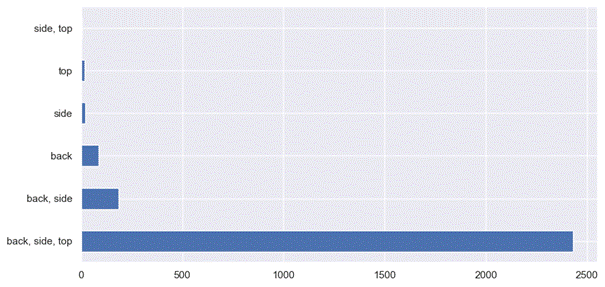
Fig. 11. Distribution of the load/unload method variable
Tab. 8
Median
rate per km of route by load/unload method
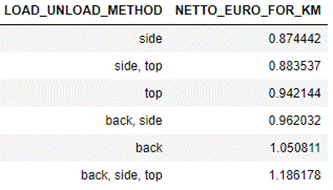
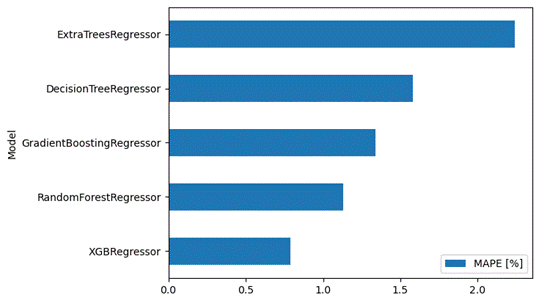
Fig. 12. Comparison of MAPE models
The
second most important category is relationship (0.16 RELATION_MEDIAN,
0.12 COUNTRY_DELIVERY_MEAN, 0.08 COUNTRY_DELIVERY_PLACE,
0.07 START_DELIVERY_DATA_YEAR, 0.06 RELATION_MEAN, 0.02 COUNTRY_DELIVERY_MEDIAN,
0.02 RELATION, 0.01 COUNTRY_LOAD_PLACE, 0.01 LOAD_COUNTRY_MEAN, 0.01 COUNTRY_DELIVERY_STD).
The
most important features also include those related to the cargo (0.02 GOODS_TYPE_MEDIAN, 0.01 M3, 0.01 LOAD_UNLOAD_METHOD_MEAN).
The
least important categories are organizational features (0.02 OTHER_COSTS) and date features (0.01 END_DELIVERY_DATA_YEAR).
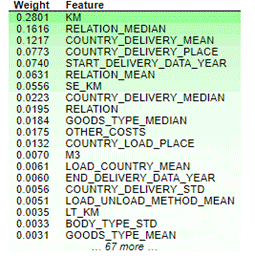
Fig. 13. Top 20 most important model features
4. DISCUSSION
The
test results of the machine learning model for forecasting freight rates
revealed many dependencies that can be observed in the market of European road
transport services. Nowakowska-Grunt and Strzelczyk
As
suggested by Inkinen and Hämäläinen
The
weekly seasonality of the freight rates that were observed in the test results
was correlated with different EU regions. This is due to the unsustainable
development of countries in terms of the price of human labor. As Kot
According
to the generalized transport cost (GTC) concept, the
maps shown by Persyn et al.
The
decision on the relationship between freight rate and the type of vehicle body
may be important in the case of investment plans implemented in transport
companies. The test results of the model presented refrigerated trucks to be
the most profitable. However, as shown by Amaruchkul
et al.
5. CONCLUSIONS
The
paper concerned the problem of the construction of freight rates and components
in road transport. Forecasting freight prices is a complex task that involves
considering various factors and variables that can affect pricing dynamics in
the sustainable transportation industry and business. Therefore, scientists
experiment with different techniques and evaluate their performance using
appropriate metrics to find the best solution for a specific prediction task.
The theoretical analysis of previous publications revealed research especially
visible in the field of road transportation freight rate forecasting. However,
through a literature review, great opportunities offered by artificial
intelligence techniques, including machine learning, which can be used to
predict transport prices have also been noticed.
For
this reason, the road freight rate forecasting model based on the machine
learning lifecycle procedure was proposed as a supporting tool in sustainable
road transport decision-making. The model is based on the most important
features of freight rates: distance, relation, vehicle type, body type, or
other characteristics which can be applied to the method depending on own
needs. The results of the model test were carried out based on 2748 datasets of
2,688 full truck load transport services offers (FTL)
collected in the freight exchange market during the years 2018-2022. The
analysis revealed interesting mechanisms of freight rate creation in the
European market. The analyzed results also indicated the sensitivity of the
model to the size of the database used in the machine learning method.
The
analysis allowed us to conclude that machine learning models can be effective
in forecasting freight prices in the context of sustainable transport due to
their ability to capture complex patterns and relationships in large datasets.
The application of the described method supports stable, sustainable, and
inclusive economic growth. It allows smaller businesses in the poorest areas to
take advantage of advanced technology, leveling the playing field. The use of
the above methodology allows you to delegate time-consuming tasks that require
a lot of computing power to the model. At the same time, human resources for
tasks that require natural intelligence, such as building relationships with
contractors. The use of the model for decision-making in the management of
transport processes, which on a global scale allows you to make better
decisions that can reduce empty runs.
The
current situation is the requirement of customers for the appropriate exhaust
gas emission standard. We assume that in the future there may be similar
requirements for alternative energy sources such as electricity and hydrogen.
By collecting enough data on transport using alternative energy sources, we can
train a model that takes this into account. The methodology presented in this
article can be used to process energy source data. The use of such an approach
will make it possible to assess the costs of using ecological energy sources on
individual routes.
References
1.
Behar Alberto, Venables
Anthony. 2011. „Transport costs and international trade. A handbook of
transport economics. In A Handbook of Transport Economics , edited by André de Palma, Robin
Lindsey, Emile Quinet, and Roger Vickerman, 97. ISBN: 9781847202031.
2.
UNCTAD. 2022. „Review
of maritime transport” In: Proceedings of the United Nation Conference on
Trade and Development. Genewa
3.
Placek
Martin. „Road freight transport revenue worldwide 2019-2022”. Available at: https://www.statista.com/statistics/1288518/road-freight-transport-revenue-worldwide.
4.
Eurostat.
„International trade in goods by mode of transport”. Available at:
https://ec.europa.eu/eurostat/statistics-explained/index.php?title=International_trade_in_goods_by_mode_of_transport.
5.
Ti-insight. „European Road Freight
Transport 2023”. 2023. Report. Bath, UK.
6.
Schnepf Randy. 2006. „Price
determination in agricultural commodity markets: a primer”. Congressional
Research Service, Library of Congress. Available at:
http://research.policyarchive.org/2678.pdf.
7.
Volpe Richard, Roeger
Edward, Leibtag Ephraim. 2013. How transportation
costs affect fresh fruit and vegetable prices. Washington: Department of
Agriculture, Economic Research Service.
8.
Melas Konstantinos, Michail Nektarios. 2021. „The
relationship between commodity prices and freight rates in the dry bulk
shipping segment: A threshold regression approach”. Maritime Transport
Research. ISSN: 2666-822X. DOI:
https://doi.org/10.1016/j.martra.2021.100025.
9.
De Bok Michiel, Bart Wesseling, Jan Kiel, Onno Miete, Jan Francke. „A
sensitivity analysis of freight transport forecasts for The Netherlands”. International Journal of
Transport Economics.
45(4): 571-587. DOI: https://doi.org/10.19272/201806704003.
10. Saeed, Naima, Su
Nguyen, Kevin Cullinane, Victor Gekara,
and Prem Chhetri.
„Forecasting Container Freight Rates Using the Prophet Forecasting Method”. Transport Policy 133(2023): 86-107. DOI: https://doi.org/10.1016/j.tranpol.2023.01.012.
11.
Nielsen Peter, Liping Jiang, Niels Gorm, Malý Rytter, Gang Chen. 2014. „An Investigation of Forecast
Horizon and Observation Fit’s Influence on an Econometric Rate Forecast
Model in the Liner Shipping Industry”. Maritime Policy &
Management 41(7): 667-82. DOI: https://doi.org/10.1080/03088839.2014.960499.
12.
Chen, Yanhui,
Bin Liu, Tianzi Wang. 2021. „Analysing and Forecasting
China Containerized Freight Index with a Hybrid Decomposition-Ensemble Method
Based on EMD, Grey Wave and ARMA”. Grey Systems: Theory and Application
11(3): 358-71. ISSN: 2043-9377. DOI: https://doi.org/10.1108/GS-05-2020-0069.
13.
Jeon,
Jun-Woo, Okan Duru, Ziaul Haque Munim, Naima Saeed. 2021. „System Dynamics in the Predictive Analytics of Container
Freight Rates”. Transportation Science 55(4): 946-67. ISSN: 0041-1655.
DOI: https://doi.org/10.1287/trsc.2021.1046.
14.
Munim, Ziaul
Haque, Hans-Joachim Schramm. 2017. „Forecasting Container Shipping Freight Rates for the Far
East – Northern Europe Trade Lane”. Maritime Economics & Logistics
19(1): 106-25. ISSN: 1479-2931. DOI: https://doi.org/10.1057/s41278-016-0051-7.
15.
Schramm, Hans-Joachim, Ziaul
Haque Munim. 2021.
„Container Freight Rate Forecasting with Improved Accuracy by Integrating Soft
Facts from Practitioners”. Research in Transportation Business &
Management 41 (December): 100662. ISSN: 2210-5395. DOI: https://doi.org/10.1016/j.rtbm.2021.100662.
16.
Slack,
Brian, Elisabeth Gouvernal. 2011. „Container Freight Rates and the Role of
Surcharges”. Journal of Transport Geography 19 (6): 1482-89. ISSN:
0966-6923. DOI: https://doi.org/10.1016/j.jtrangeo.2011.09.003.
17.
Batchelor, Roy, Amir Alizadeh, Ilias Visvikis. 2007. „Forecasting Spot and Forward Prices in the
International Freight Market”. International Journal of Forecasting
23(1): 101-14. ISSN: 0169-2070. DOI: https://doi.org/10.1016/j.ijforecast.2006.07.004.
18.
Chen, Shun, Hilde Meersman,
Eddy Van De Voorde. 2012. „Forecasting Spot Rates at Main Routes in the Dry
Bulk Market”. Maritime Economics & Logistics 14(4): 498-537. ISSN:
1479-2931. DOI: https://doi.org/10.1057/mel.2012.18.
19.
Li, Kevin X., Yi Xiao, Shu-Ling
Chen, Wei Zhang, Yuquan Du, Wenming
Shi. 2018. „Dynamics and Interdependencies among
Different Shipping Freight Markets”. Maritime Policy & Management
45(7): 837-49. https://doi.org/10.1080/03088839.2018.1488187.
20.
Dikos
George, Henry S. Marcus, Martsin Panagiotis Papadatos, Vassilis
Papakonstantinou. 2006. „Niver Lines: A System-Dynamics Approach to Tanker
Freight Modeling”. Interfaces 36(4): 326-41. https://doi.org/10.1287/inte.1060.0218.
21.
Kabir
Abdulmajeed, Monsuru Adeleke, Labode Popoola. 2020. „Online forecasting of
COVID-19 cases in Nigeria using limited data”. Data in Brief 30: 105683.
ISSN: 2352-3409. DOI: https://doi.org/10.1016/j.dib.2020.105683.
22.
Kasimati
Evangelia, Nikolaos Veraros. 2018. „Accuracy of Forward Freight Agreements in
Forecasting Future Freight Rates”. Applied Economics 50(7): 743-56.
ISSN: 0003-6846. DOI: https://doi.org/10.1080/00036846.2017.1340573.
23.
Munim
Ziaul Haque. 2022. „State-Space TBATS Model for Container Freight Rate
Forecasting with Improved Accuracy”. Maritime Transport Research 3:
100057. ISSN: 2666-822X. DOI: https://doi.org/10.1016/j.martra.2022.100057.
24.
Duru
Okan, Emrah Gulay, Korkut Bekiroglu. 2023. „Predictability of the Physical
Shipping Market by Freight Derivatives”. IEEE Transactions on Engineering
Management 70(1): 267-79. ISSN: 0018-9391. DOI: https://doi.org/10.1109/TEM.2020.3046930.
25.
Lam
Jasmine Siu Lee, Qingyao Li, Shuyi Pu. 2021. „Volatility and Uncertainty in
Container Shipping Market“. In: New Maritime Business, edited by Byoung-Wook Ko and Dong-Wook Song, 10: 11-32.
WMU Studies in Maritime Affairs. Cham: Springer International Publishing. ISBN:
978-3-030-78956-5 978-3-030-78957-2.
26.
Choudhary,
Ankur, Santosh Kumar, Manish Sharma, K.P. Sharma. 2022. „A Framework for Data
Prediction and Forecasting in WSN with Auto ARIMA”. Wireless Personal
Communications 123(3): 2245-59. ISNN: 0929-6212. DOI: https://doi.org/10.1007/s11277-021-09237-x.
27.
Al-Qazzaz Redha Ali, Suhad Yousif. 2022. ”High Performance Time Series Models Using Auto
Autoregressive Integrated Moving Average”. Indonesian Journal of Electrical
Engineering and Computer Science 27(1): 422. ISSN: 2502-4760. DOI: https://doi.org/10.11591/ijeecs.v27.i1.pp422-430.
28.
Nguyen
Huy Vuong, M. Asif Naeem, Nuttanan Wichitaksorn, Russel Pears. 2019. „A Smart System for Short-Term Price Prediction Using Time Series
Models”. Computers & Electrical Engineering 76(June): 339-52. ISSN:
0045-7906. DOI: https://doi.org/10.1016/j.compeleceng.2019.04.013.
29.
Kumar
Dubey Ashutosh, Abhishek Kumar, Vicente García-Díaz, Arpit Kumar Sharma, Kishan
Kanhaiya. 2021. ‚Study and Analysis of SARIMA and LSTM in Forecasting Time
Series Data”. Sustainable Energy Technologies and Assessments
47(October): 101474. ISSN: 2213-1388 https://doi.org/10.1016/j.seta.2021.101474.
30.
Makridakis
Spyros, Evangelos Spiliotis, Vassilios Assimakopoulos. 2020. „The M4
Competition: 100,000 Time Series and 61 Forecasting Methods”. International
Journal of Forecasting 36(1): 54-74. ISSN: 0169-2070. DOI: https://doi.org/10.1016/j.ijforecast.2019.04.014.
31.
Mazanec
Jaroslav, Veronika Harantová, Vladimíra Štefancová, Hana Brůhová Foltýnová.
2023. „Estimating Mode of Transport in Daily Mobility during the COVID-19
Pandemic Using a Multinomial Logistic Regression Model”. International
Journal of Environmental Research and Public Health 20(5): 4600. ISSN:
1660-4601. DOI: https://doi.org/10.3390/ijerph20054600.
32.
Al Hasan Mohammad, Li Xiong. 2022. „Do simpler statistical methods perform better in
multivariate long sequence time-series forecasting? ”. In: Proceedings of
the 31st ACM International Conference on Information & Knowledge Management.
Atlanta GA USA: ACM.
33.
Hyndman, Rob J., Yeasmin
Khandakar. 2008.
„Automatic Time Series Forecasting: The Forecast Package for R”. Journal of Statistical
Software 27(3). ISSN: 1548-7660. DOI: https://doi.org/10.18637/jss.v027.i03.
34.
Navratil
Miroslav, Andrea Kolkova. 2019. „Decomposition and Forecasting Time Series in
the Business Economy Using Prophet Forecasting Model”. Central European
Business Review 8(4): 26-39. ISSN: 18054854. DOI: https://doi.org/10.18267/j.cebr.221.
35.
Papacharalampous
Georgia A., Hristos Tyralis. 2018. „Evaluation of Random Forests and Prophet
for Daily Streamflow Forecasting”. Advances in Geosciences 45(August):
201-8. ISSN: 1680-7359. DOI: https://doi.org/10.5194/adgeo-45-201-2018.
36.
Chuwang Dung David, Weiya
Chen. 2022. „Forecasting Daily and Weekly Passenger
Demand for Urban Rail Transit Stations Based on a Time Series Model Approach”. Forecasting
4(4): 904-24. ISSN: 2571-9394. DOI: https://doi.org/10.3390/forecast4040049.
37.
Widodo
Agus, Indra Budi, Belawati Widjaja. 2016. „Automatic Lag Selection in Time
Series Forecasting Using Multiple Kernel Learning”. International Journal of
Machine Learning and Cybernetics 7(1): 95-110. ISSN: 1868-8071. DOI: https://doi.org/10.1007/s13042-015-0409-7.
38.
Mrowczynska Bogna, Maria Ciesla,
Aleksander Krol, Aleksander Sladkowski.
2017. „Application of Artificial Intelligence
in Prediction of Road Freight Transportation”. PROMET –
Traffic&Transportation 29(4): 363-70. ISSN: 1848-4069. DOI: https://doi.org/10.7307/ptt.v29i4.2227.
39.
Züfle
Marwin, Samuel Kounev. 2020. „A Framework for Time Series Preprocessing and
History-Based Forecasting Method Recommendation”. In: Proceedings of the
2020 Federated Conference on Computer Science and Information Systems, edited by M. Ganzha, L. Maciaszek, M. Paprzycki, ACSIS: 141-44.
40.
Martínez Francisco, María Pilar Frías, María Dolores
Pérez, Antonio Jesús Rivera. 2019. „A
Methodology for Applying K-Nearest Neighbor to Time Series Forecasting”. Artificial
Intelligence Review 52(3): 2019-37. ISSN: 0269-2821. DOI: https://doi.org/10.1007/s10462-017-9593-z.
41.
Bogachev
Taras, Tamara Alekseychik, Anatoly Chuvenkov, Svetlana Batygova. 2021.
„Comparative Assessment of the Regional Freight Transportation by Method of
Fuzzy Linear Regression”. In: 14th International Conference on Theory and
Application of Fuzzy Systems and Soft Computing – ICAFS-2020, edited by Rafik
A. Aliev, Janusz Kacprzyk, Witold Pedrycz, Mo Jamshidi,
Mustafa Babanli, Fahreddin M. Sadikoglu, 1306: 102-9. Advances in Intelligent Systems and Computing. Cham: Springer
International Publishing. ISBN: 978-3-030-64057-6 978-3-030-64058-3.
42.
Khan Ibraheem
Abdulhafiz, Farookh Khadeer Hussain. 2022. „Regression Analysis Using Machine
Learning Approaches for Predicting Container Shipping Rates”. In: Advanced
Information Networking and Applications, edited by Leonard Barolli, Farookh
Hussain, and Tomoya Enokido, 450: 269-80. Lecture
Notes in Networks and Systems. Cham: Springer International Publishing.
ISBN: 978-3-030-99586-7. DOI: https://doi.org/10.1007/978-3-030-99587-4_23.
43.
Koyuncu
Kaan, Leyla Tavacioğlu. 2021. „Forecasting Shanghai Containerized Freight
Index by Using Time Series Models”. Marine Science and Technology Bulletin
10(4): 426-34. ISSN: 2147-9666. DOI: https://doi.org/10.33714/masteb.1024663.
44.
Bashir
Sara, Milan Zlatkovic. 2021. „Assessment of Queue Warning Application on
Signalized Intersections for Connected Freight Vehicles”. Transportation
Research Record: Journal of the Transportation Research Board 2675(10):
1211-21. DOI: https://doi.org/10.1177/03611981211015247.
45.
Gladchenko E.A., O.N. Saprykin, AN. Tikhonov. 2019. „Optimization of urban freight transportation based on
evolutionary modelling”. In: CEUR Workshop Proceedings 2019”: 95-103.
46.
Kluyver
Thomas, Ragan-Kelley Benjamin, Pérez Fernando, Granger Brian, Bussonnier Matthias,
Frederic Jonathan, Kelley Kyle, Hamrick Jessica, Grout Jason, Corlay Sylvain,
Ivanov Paul, Avila Damián, Abdalla Safia, Willing Carol. 2016. „Jupyter
Notebooks – a publishing format for reproducible computational workflows”.
In: 20th International Conference on Electronic Publishing”: 87-90.
47.
McKinney
Wes. 2010. „Data Structures for Statistical Computing in Python”. In: Proc. of the 9th Python in Science Conf.
(SCIPY 2010): 56-61. Austin, Texas. DOI: https://doi.org/10.25080/Majora-92bf1922-00a.
48.
Waskom
Michael. 2021. „Seaborn: Statistical Data Visualization”. Journal of Open
Source Software 6(60): 3021. DOI: https://doi.org/10.21105/joss.03021.
49.
Hunter
John D. 2007. „Matplotlib: A 2D Graphics Environment”. Computing in Science
& Engineering 9(3): 90-95. DOI: https://doi.org/10.1109/MCSE.2007.55.
50.
Pedregosa
Fabian, Gaël Varoquaux, Alexandre Gramfort, Vincent Michel, Bertrand Thirion,
Olivier Grisel, Mathieu Blondel, et al. 2012. „Scikit-Learn: Machine Learning
in Python”. arXiv: 1201.0490. DOI: https://doi.org/10.48550/ARXIV.1201.0490.
51.
Built-in
Types. The Python Standard Library. Available at: https://docs.python.org/3/library/stdtypes.html.
52.
Eur-Lex.
Regulation (EC) No 561/2006 of the European Parliament and of the Council of 15
March 2006 on the harmonisation of certain social legislation relating to road
transport. 2006. Available at: https://eur-lex.europa.eu/legal-content/EN/ALL/?uri=CELEX%3A32006R0561.
53.
Nowakowska-Grunt Joanna,
Monika Strzelczyk. 2019. „The Current
Situation and the Directions of Changes in Road Freight Transport in the
European Union”. Transportation Research Procedia 39: 350-59. ISSN:
2352-1465. DOI: https://doi.org/10.1016/j.trpro.2019.06.037.
54.
Eurostat.
Road freight transport performance by type of operation, 2017-2021. Available at:
https://ec.europa.eu/eurostat/databrowser/product/page/ROAD_GO_TA_TOTT.
55.
Eurostat.
Road freight transport performance by distance class, 2021. Available at: https://ec.europa.eu/eurostat/databrowser/view/ROAD_GO_TA_DC/default/table?lang=en&category=road.road_go.road_go_tot.
56.
Inkinen
Tommi, Esa Hämäläinen. 2020. „Reviewing Truck Logistics: Solutions for
Achieving Low Emission Road Freight Transport”. Sustainability 12(17):
6714. DOI: https://doi.org/10.3390/su12176714.
57.
Zgonc Borut, Metka Tekavčič, Marko Jakšič. 2019. „The Impact of Distance on Mode Choice in Freight
Transport”. European Transport Research Review 11(1): 10. ISSN:
1867-0717. DOI: https://doi.org/10.1186/s12544-019-0346-8.
58.
den Boer
Eelco, Essen Huib, Brouwer Femke, Pastori Enrico, Moizo Alessandra. 2011. Potential of modal shift to rail
transport-Study on the projected effects on GHG emissions and transport volumes.
CE Delft. Publication No. 11.4255.15.
59.
Kot
Sebastian. 2015. ”Cost Structure in Relation to the Size of Road Transport
Enterprises”. PROMET -
Traffic&Transportation 27(5): 387-94. ISSN: 1848-4069. DOI: https://doi.org/10.7307/ptt.v27i5.1687.
60.
Lükewille
Anke, Imrich Bertok, Markus Amann, Janusz Cofala, Frantisek Gyarfas, Chris Heyes, Niko Karvosenoja, Zbigniew Klimont, Wolfgang Schöpp.
2021. A Framework to Estimate
the Potential and Costs for the Control of Fine Particulate Emissions in Europe. IIASA Interim Report. IIASA, Laxenburg, Austria:
IR-01-023.
61.
Poliak
Miloš, Patricia Šimurková, Kelvin Cheu. 2019. „Wage Inequality Across The Road Transport Sector Within the Eu”. Transport
Problems 14(2): 145-53. ISSN: 1896-0596.
DOI: https://doi.org/10.20858/tp.2019.14.2.13.
62.
Persyn,
Damiaan, Jorge Díaz-Lanchas, Javier Barbero. 2022. „Estimating Road Transport
Costs between and within European Union Regions”. Transport Policy 124
(August): 33-42. ISSN: 0967-070X. DOI: https://doi.org/10.1016/j.tranpol.2020.04.006.
63.
Poliak Milos, Adela Poliakova, Lucie Svabova, Natalia
Aleksandrovna Zhuravleva, Elvira Nica. 2021. „Competitiveness of Price in International Road Freight
Transport”. Journal of Competitiveness 13(2): 83-98. ISSN: 1804-171X.
DOI: https://doi.org/10.7441/joc.2021.02.05.
64.
Liachovičius
Edvardas, Viktor Skrickij. 2020. „The Challenges and Opportunities for Road
Freight Transport“. In: TRANSBALTICA XI: Transportation Science and
Technology, edited by Kasthurirangan Gopalakrishnan, Olegas Prentkovskis,
Irina Jackiva, Raimundas Junevičius, 455-65. Lecture Notes in Intelligent Transportation
and Infrastructure. Cham: Springer International Publishing.
65.
Konečný
Vladimír, Semanová Štefánia, Gnap Jozef, Stopka Ondrej. 2018. ”Taxes and
Charges in Road Freight Transport – a Comparative Study of the Level of Taxes
and Charges in the Slovak Republic and the Selected EU Countries”. Naše More
65(4): 208-12. ISBN: 978-3-030-38665-8. DOI: https://doi.org/10.17818/NM/2018/4SI.8.
66.
Hájek
Miroslav, Jarmila Zimmermannová, Karel Helman. 2021. „Environmental Efficiency
of Economic Instruments in Tansport in EU Countries”. Transportation
Research Part D: Transport and Environment 100 (November): 103054. ISSN:
1361-9209. DOI: https://doi.org/10.1016/j.trd.2021.103054.
67.
Siksnelyte-Butkiene
Indre, Dalia Streimikiene. 2022. „Sustainable Development of Road Transport in
the EU: Multi-Criteria Analysis of Countries Achievements”. Energies 15(21):
8291. ISSN: 1996-1073. DOI: https://doi.org/10.3390/en15218291.
68.
Amaruchkul
Kannapha, Akkaranan Pongsathornwiwat, Purinut Bantadtiang. 2022. „Constrained
Joint Replenishment Problem with Refrigerated Vehicles”. Engineering Journal
26(1): 75-91. ISSN: 01258281. DOI: https://doi.org/10.4186/ej.2022.26.1.75.
69.
Kubáňová
Jaroslava, Iveta Kubasáková, Dočkalik. 2021. „Analysis of the Vehicle Fleet in
the EU with Regard to Emissions Standards”. Transportation Research Procedia
53: 180-87. DOI: https://doi.org/10.1016/j.trpro.2021.02.024.
70.
ACEA. Zero-emission
trucks require radical policy changes, says ACEA as new fleet data is released.
Available at:
https://www.acea.auto/press-release/zero-emission-trucks-require-radical-policy-changes-says-acea-as-new-fleet-data-is-released/
Received 17.06.2024; accepted in
revised form 05.10.2024
![]()
Scientific Journal of Silesian University of Technology. Series
Transport is licensed under a Creative Commons Attribution 4.0
International License
